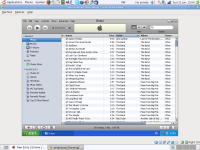 Take a look at this screenshot. Click on the image to enlarge it. Do you see what I see?
Take a look at this screenshot. Click on the image to enlarge it. Do you see what I see?
In the center of your screen is Apple iTunes software. But look carefully at the top bar, particularly the upper left corner. That’s Ubuntu. What you’re seeing is an implementation of iTunes inside the Ubuntu Linux desktop.
So what?
Well, if you buy an iPod or iPhone, Apple tells you that the only computers that they will work with are Apple Macs and Microsoft Windows PCs. If you run Linux, you’re out of luck.
If you Google around, you discover that there are ways around this. As you’d expect.
Most people suggest that you “jailbreak” your iPod but that is (a) tricky to do for newbies and (b) runs the risk of invalidating your warranty, and screwing up stuff.
You could partition your disk and install Windows in one of the partitions, but when I started reading up on this, I realized that there was a risk of compromising some bits of my system that I didn’t want to touch.
Another approach, which I tried, is to install an app on the iPod called Air Sharing. This allows me to drag and drop files, including music files, from my Linux laptop to the iPod. It works really well, but the problem is that you cannot play those files with the music player. If you double click on a particular music file, you can play it — but you can’t play a number of them, or shuffle them, or do anything a decent music player would do.
I tried to run iTunes in the Windows emulator for Linux, Wine (and yes, I know that means “Wine is not an emulator”), but that didn’t work.
And then I discovered Sun Microsystem’s VirtualBox and everything changed.
VirtualBox is free software which you can download to your Linux desktop.
Once you do so, you tell it to create a new virtual environment and you can set up your operating system (in my case, Windows XP Home) inside that environment (or box).
It takes a while to install Windows XP from CD, but incredibly, it worked. I had Windows working on my Linux desktop, without having to partition my disk.
Once Windows was working inside its little box, I checked to see if it recognized that I had a wireless internet connection. It did. So I downloaded and set up iTunes 8. That worked really well.
The next stage was tricky — how to get iTunes to read all the MP3 files I had created in Linux.
For that, I needed to use Shared Folders inside VirtualBox, which required me to download some additional tools (you’ll be walked through this), and to restart.
I was very happy to see iTunes now recognizing all my music files.
The final stage was getting iTunes to recognize the iPod once it was connected by USB. This was not simple, and required me to play around with user groups on Linux. There’s a lot of stuff about this on the web and it took a while to tweak it all so it worked.
And then, it all just worked. I was syncing my iPod Touch with my Linux-based music collection — without jailbreaks, without partitions.
Life would be a lot easier if Apple would just release a version of iTunes for Linux, but the company is obviously not interested in the millions of Linux users as potential customers of both their hardware (iPods and iPhones) and music. Until they wake up to the fact that we are a market, we need to find ways to get around their stupid limitations — and what I’ve described above is one way to do just that.